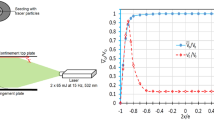Abstract
The drag of non-evaporating, spherical, liquid droplets was measured in turbulent flow fields at parametric ranges relevant to spray combustion, characterized by the droplet Reynolds number, and the intensity and spatial scales of turbulence. The experimental apparatus comprised a wind-tunnel and a piezo-electric droplet generator. The procedure was to inject water droplets of uniform size co-currently and continuously with vertical turbulent air flows while droplet velocity was measured at different elevations using laser-Doppler velocimetry. Turbulence was characterized using hot-wire anemometry prior to droplet injection. Drag coefficients were calculated using these main measurements and the law of conservation of mechanical energy. Reynolds numbers were investigated in the range 10–100, in terms of the equivalent spherical diameter of a droplet, and the mean relative speed between the ambient gaseous field and the droplets. Weber numbers were much less than unity so droplets were effectively spherical. Relative intensities of turbulence were investigated in the range 20–65 percent, in terms of the mean relative speed. Spatial scales of turbulence were large in comparison to the droplets; the ratio between the spatial integral scale and the droplet diameter was in the range 11–38, and the Kolmogorov scale was comparable in size or smaller than the droplet diameter. Experimental data showed that the drag in turbulent fields under these conditions is not significantly different than that of solid spheres in a quiescent field at the same Reynolds number.
Similar content being viewed by others
References
American Society of Heating, Refrigerating, and Air-Conditioning Engineers, Inc. (ASHRAE) 1989: Fundamentals handbook. New York: Author
Anderson TJ; Uhlherr PHT (1977) The influence of stream turbulence on the drag coefficient of freely entrained spheres. In: Preprints of papers to the sixth Australasian Hydraulics and Fluid Mechanics Conference (pp 541–545). Australia: Institute of Engineers
Clift R; Gauvin WH (1970) The motion of particles in turbulent gas streams. In: Chemeca 70: A conference convened by the Australian National Committee of the Institution of Chemical Engineers and the Australian Academy of Science (pp 14–28). Chatswood, Australia: Butterworths of Australia and the Institution of Chemical Engineers
Clift R; Gauvin WH (1971) Motion of entrained particles in gas streams. The Canadian Journal of Chemical Engineering 49: 439–448
Clift R; Grace JR; Weber ME (1978) Bubbles, drops, and particles. New York: Academic Press
Comte-Bellot G; Corrsin S (1971) Simple Eulerian time correlation of full- and narrow-band velocity signals in grid-generated, ‘isotropic’ turbulence. J Fluid Mech 48: 273–337
Faeth GM (1983) Evaporation and combustion of sprays. Prog Energy Combust Sci 9: 1–76
Faeth GM (1987) Mixing, transport and combustion in sprays. Prog Energy Combust Sci 13: 293–345
Hinze JO (1975) Turbulence (2nd ed). New York: McGraw-Hill
Lee SL (1987) Particle drag in a dilute turbulent two-phase suspension flow. Int J Multiphase Flow 13: 247–256
Mei R (1994) Effect of turbulence on the particle settling velocity in the nonlinear drag range. Int J Multiphase Flow 20: 273–284
Neter J; Wasserman W (1974) Applied linear statistical models: Regression, analysis of variance, and experimental design. Homewood, IL: Richard D. Irwin
Neve RS (1986) The importance of turbulence macroscale in determining the drag coefficient of spheres. Int J Heat Fluid Flow 7: 28–36
Petrak D (1976) Der strömungswiderstand frei beweglicher einzel- und schwarmkugeln bei turbulenter anströmung entgegengesetzi zur bewegungsrichtung [Drag force of freely moving single and cloud spheres in case of counter current turbulent gas-solid flow]. Chemische Technik 28: 591–595
Raznjevič K (1976) Handbook of thermodynamic tables and charts. New York: McGraw-Hill
Roach PE (1987) The generation of nearly isotropic turbulence by means of grids. J Heat Fluid Flow 8: 82–92
Torobin LB; Gauvin WH (1961) The drag coefficients of single spheres moving in steady and accelerated motion in a turbulent field. AIChE J 7: 615–619
Uhlherr PHT; Sinclair CG (1970) The effect of free-stream turbulence on the drag coefficient of sphere. In: Chemeca '70: A conference convened by the Australian National Committee of the Institution of Chemical Engineers and the Australian Academy of Science (pp 1–13). Chatswood, Australia: Butterworths of Australia and the Institution of Chemical Engineers
Warnica WD (1992) Drag coefficients of droplets in turbulent flow fields. Ph.D. Thesis, University of Waterloo: Waterloo, Ontario, Canada
Warnica WD; Renksizbulut M; Strong AB (1994) Drag coefficients of spherical liquid droplets; Part 1: Quiescent gaseous fields. Exp Fluids 18: 258–264
Warnica WD; Van Reenen M; Renksizbulut M; Strong AB (1991) A piezoelectric droplet generator for use in wind tunnels. Rev Sci Instrum 62: 3037–3046
Warnica WD; Van Reenen M; Renksizbulut M; Strong AB (1993) Charge synchronization for a piezoelectric droplet generator. Rev Sci Instrum 64: 2334–2339
Zarin NA; Nicholls JA (1971) Sphere drag in solid rockets — Non-continuum and turbulence effects. Combustion Science and Technology 3: 273–285
Author information
Authors and Affiliations
Additional information
The financial support of the Natural Sciences and Engineering Research Council of Canada and the Manufacturing Research Corporation of Ontario is gratefully acknowledged.
Rights and permissions
About this article
Cite this article
Warnica, W.D., Renksizbulut, M. & Strong, A.B. Drag coefficients of spherical liquid droplets Part 2: Turbulent gaseous fields. Experiments in Fluids 18, 265–276 (1995). https://doi.org/10.1007/BF00195097
Received:
Accepted:
Issue Date:
DOI: https://doi.org/10.1007/BF00195097



